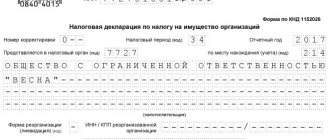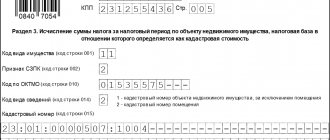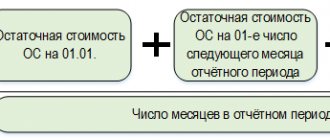Who reports property taxes?
The obligation to submit a property declaration with the calculation of the tax payable at the end of 2021 is assigned to legal entities that have fixed assets on their balance sheet that are subject to the specified tax.
When reporting for 2021, you need to submit information about the average annual value of property. In this regard, the tax authorities finalized the property tax declaration, approving its new form. The order with the updated form comes into force on March 14, 2021. Is it possible to report for 2021 using the new form? Let’s find out here.
If the company does not have taxable objects, then zero (as, for example, for VAT) does not need to be submitted.
Special regimes under the simplified tax system reflect in the corporate property tax return for 2021 only those properties for which the cadastral value was determined as of January 1 of this year. Simplified residents are exempt from calculating and paying property tax, assessed at the average annual value.
Enterprises on the Unified Agricultural Tax show in the report assets that were not involved in agricultural activities (clause 3 of Article 346.1 of the Tax Code of the Russian Federation).
Individuals, regardless of whether they have the status of individual entrepreneur, lawyer, notary, etc., do not report on property tax. Their responsibility is to pay tax upon notification, where the amount of the liability has already been calculated by the tax authority.
Division of property in case of divorce with children when filing a claim in court
The ideal option for dividing property if there are small children in the family would be to conclude a settlement agreement. However, judicial practice shows that not all spouses can reach mutual understanding even at the preliminary stage of negotiations. In such a situation, they have to divide the property through the court.
Certain nuances regarding the protection of the interests of minor children during parental divorce are stipulated in family law and the Civil Code and relate to the following issues:
- determining the size of the share of the spouse with whom the child remains to live;
- establishing the amount of compensation for indivisible objects to the parent and reducing it for the one who takes care of the child;
- allocation of a share of property (real estate) if maternity capital or funds belonging to the child by right of inheritance or gift were used for its purchase.
Divorce with division of property and a minor child does not have a single algorithm for making decisions on the size of shares of jointly acquired property for each party. The court will have to determine the fairness of the parents' demands and compliance with legal norms based largely on evaluative criteria:
- the child’s health status - if he has a confirmed disability or documented systemic diseases, the share of the caring parent may be increased;
- the presence of health restrictions, lack of income for objective reasons (the status of a caregiver - a person caring for them) of the spouse with whom the child lives;
- the need for increased funding aimed at supporting the development of the child - for example, expenses for sports clubs, payment for music education;
- the physical participation of the second spouse in the lives of the children - his involvement in their development, trips on vacation.
Example: When a couple divorced, a boy with cerebral palsy remained in the care of his mother. Due to the fact that his condition required regular travel to visit a rehabilitation center, the car purchased during marriage went to the child’s ex-wife. The husband received compensation, but the amount, taking into account the special condition of the child, was reduced and did not become a serious burden for the mother.
All this applies to property acquired in a joint marriage by parents. But there are things that the court will consider the personal property of a child, even a minor.
How the property declaration form has changed in 2021 - 2021
In 2021, the Federal Tax Service approved a new form and electronic format for submitting a property declaration by order dated August 14, 2019 No. SA-7-21/405. In 2021, changes were made to it (order dated July 28, 2020 No. ED [email protected] ). Therefore, you need to report for 2021 using an updated form. 2021 property tax returns are available for free using the link below:
This order only approved the form of the annual declaration - there is no form for calculating advance payments. This is due to the fact that starting from 2021, quarterly reporting on property is no longer necessary, while the obligation to pay advances throughout the year remains with organizations.
Please note that from March 14, 2021, a new property tax declaration form will be used from the Federal Tax Service order dated December 9, 2020 No. KCh-7-21/ [email protected] The possibility of applying the new declaration form earlier (before March 14, 2021) is not separately specified in it . Thus, those wishing to report on the new form for 2021 should either wait for additional clarification from the Federal Tax Service, or contact their tax office with a question on what form the declaration can be submitted in before March 14, 2021.
ConsultantPlus experts explained what changes have been made to the property tax declaration form, valid from March 14, 2021. Get trial demo access to the K+ system and go to the review material for free.
Next, we will tell you how to step-by-step prepare a new property tax return for 2021 using the form from Order No. SA-7-21/405 dated August 14, 2019 (as amended on July 28, 2020 No. ED [email protected] ).
Property that is divisible and not divisible
As a general rule, everything acquired by spouses during marriage from common income through compensated transactions, as well as the income itself and funds, are jointly acquired property. Such property becomes the common property of the spouses, even if it is registered in the name of one of them. But it happens that one of the spouses gets a car or an apartment, or a plot of land by inheritance or under a gift agreement. This is personal property and cannot be divided. In order to determine which property will be divided and which will not, you need to understand:
- under a compensation agreement, this property came into ownership or free of charge.
- on income received during marriage or on premarital funds.
- purchased with funds received from the sale of personal property (received as a gift, inheritance, belonging to the spouse before marriage), or from common income.
- purchased for children or not.
- whether it is a luxury item or not.
Property that belonged to each spouse before marriage is not divided. Property that, although acquired during marriage, was purchased for children is also not divided. For example, if a couple bought a computer for a child to do schoolwork or sports equipment, then this is the child’s property; parents cannot lay claim to such property. Items for personal use are also the personal property of the spouse for whom they were purchased, except for jewelry and luxury items.
Despite such a clear rule, in practice spouses may encounter situations from which a way out can only be found by knowing the judicial practice. Not all issues are regulated by the Family Code of the Russian Federation. Courts are still developing approaches to solving problems that are not expressly described in the law.
Who should pay for the division of property?
PlaintiffDefendant
For example,
an apartment purchased under a gratuitous agreement becomes the personal property of the spouse and is not subject to division .
But if such an apartment was significantly improved at the expense of the joint income of the spouses - repaired, redesigned, reconstructed - then it can be recognized as common property. A plot of land provided free of charge by order or decree of the municipality also belongs to the common property of the spouses. To understand the correct prospects for the division of property, it is necessary to take into account not only the general rules, but also the nuances enshrined in judicial practice. The variety of property disputes has created a variety of options for resolving such disputes.
How to divide a car after a divorce
A car is an indivisible property, so in most cases it is transferred into the ownership of one of the spouses. When transferring a car, the court takes into account which spouse uses the car more often, who needs it for work, who has a driver's license and is interested in using the car. The court awards monetary compensation to the second spouse in proportion to the share in the right to the car. If the shares are considered equal, then the compensation will be half the cost of the car. To determine the value of the car, the court orders an examination, which determines the fair market value of the property.
Inherited property
Property received by one of the spouses by inheritance is the property of that spouse. This rule is enshrined in Article 36 of the Family Code. The second spouse has no right to claim such property. But just as there are exceptions to every rule, inherited property can be recognized by the court as the common property of the spouses. This is possible if the inheritance received in property was improved at the expense of the common income of the husband and wife, at the expense of the property of each of the spouses or the labor of one of the spouses. For example, a wife inherited a country house. Both spouses worked and used their earnings to renovate the house, adding a veranda and a second floor to it. In this case, the court may recognize the house as the common property of the spouses.
Debts and mortgages of spouses
As mentioned above, when dividing property, one must remember that all debts acquired during the marriage will have to be divided, including real estate taken on a mortgage.
The division of debts is always a very painful topic; often one of the spouses may not know anything that the second spouse has taken out a loan. To protect against abuse, the Family Code establishes a rule according to which only those debts that arose with the consent of the second spouse and were spent on the needs of the family are recognized as common debts that are subject to division. According to Russian law, in order to take out a consumer loan or a regular loan, the consent of the second spouse is not required; banks require such consent only when concluding a mortgage loan. Therefore, during the divorce process, it may turn out that one of the spouses has accumulated loans, which will now have to be divided equally. Dividing debts does not mean that each spouse will be ordered to pay half of the loan. In practice, everything happens differently. If the loan, including a mortgage, was issued to one spouse, then he will continue to repay the loan. After the shares in the property are recognized as equal, the spouse paying the loan has the right to recover half of the payments from the second spouse. To do this, you should apply to the court with a request to recognize the loan debt as common property. If you do not make such a claim, you will lose the opportunity to recover half of the payments from your ex-spouse.
To divide loans issued during a marriage, including mortgages, you need to file a lawsuit to recognize the loan debt as the common property of the spouses and determine the spouses’ shares in the debt obligation.
Personal property
When it comes to dividing property, it is necessary to immediately determine which property should be excluded from the division. It is considered the personal property of each spouse and is not subject to division:
- property that belonged to each spouse before marriage.
- property received by one of the spouses during marriage as a gift, passed on by inheritance or through other gratuitous transactions.
- things for personal use (clothes, shoes and others), but these do not include jewelry and other luxury items, although acquired during the marriage at the expense of the spouses’ common funds.
- exclusive right to the result of intellectual activity, for example, a book, painting, scientific work, etc.
It is more difficult to protect your property from division if personal property was sold during the marriage and a new item was purchased with the proceeds. There is a risk that such an item will be recognized as common property. According to the law, the money received by a spouse from the sale of personal property belongs only to him. This is his personal property. But difficulties arise if it is not possible to distinguish this money from the general family budget.
If personal property is sold during a marriage—whether it was acquired before the marriage or received as a gift or inheritance during the marriage—then keep the proceeds in a separate account . This will allow, in the event of a dispute, to distinguish between jointly acquired property and your personal funds.
Business section
When deciding on the division of a business, we are talking about the division of real and movable property that is used for business purposes, as well as the division of shares and shares in the authorized capital of commercial companies.
When dividing a business, it is necessary to take into account many nuances and in each case develop an individual line of defense. There are several options for resolving a property dispute:
- shares in the authorized capital and shares can be divided like any other property.
- a spouse who is a member of the company can leave the company, receive the actual value of his share and divide it by agreement with the second spouse.
- the business owner spouse can provide the second spouse with compensation in accordance with the share due to him - cash or real estate.
- a share in the authorized capital or shares can be sold and the proceeds divided.
Often, one of the spouses runs the business, so when dividing property, they actively resist giving up anything related to the business. Such cases are the most complex and require the participation of a lawyer in order to understand the intricacies of property relations and make a fair division.
| Shares | Doesn't share |
| Movable property (vehicles, etc.) | Received as an inheritance or as a gift |
| Real estate (house, apartment, room, garage, cottage and other buildings) | Personal belongings and hygiene items. Property necessary for further activities (including cars) |
| Electronics and household appliances | Rights to the results of activities and creativity |
| Income, savings and debt obligations | Property acquired before marriage or after its dissolution |
| Securities, deposits and investment units | Payments from personal insurance |
| Luxury items (jewelry, paintings, etc.) | Any property of children |
What to follow when entering data into the declaration
The rules for filling out the property tax return for 2021 correspond to the basic requirements for filling out other reports submitted to the tax authorities. All of them are contained in the order of completion approved by the same order No. SA-7-21/405 (as amended on July 28, 2020 No. ED [email protected] ):
- When completing a declaration manually, blue, black or purple ink is used.
- When filling out in an automated way, you can use special accounting programs, reporting programs, or enter data into a form in Excel.
- All pages are numbered in order, starting with the title page.
- Duplex printing on the printer, as well as binding sheets with staples or paper clips, are not permitted.
- The fields are filled with the values of text, numeric, code indicators from left to right, starting from the leftmost familiarity.
- Cost figures are rounded to whole numbers.
- You cannot correct errors using a barcode corrector.
The declaration consists of a title page and sections 1, 2, 2.1 and 3. View and download a completed sample property tax declaration - 2021 in ConsultantPlus, receiving free trial demo access to the system using the link below:
Title page
The title book contains information about the reporting organization: TIN and KPP, which are then repeated on each page of the report, full name and contact phone number.
In case of reorganization, it is necessary to indicate on the first page the code of the reorganization (or liquidation) form, TIN and KPP of the reorganized company.
In addition to this information, the title page reflects information directly on the report itself:
- Correction number (put “0” when submitting the original form).
- Reporting year.
- Codes:
- tax period;
- tax authority;
- registration at the location.
All data is certified by the signature of the manager or authorized representative and the seal of the organization. The date of completion (or certification) of the report is also indicated here.
After completing the title card, they proceed to filling out section 2 together with 2.1 and 3, depending on the presence of one or another type of property at the enterprise.
Section 2
This section is a tax calculation based on the average annual value of property on the company’s balance sheet. The lines are filled in as follows:
Section 2.1
This section is filled in with information about the property, the tax on the value of which was calculated in section 2. Information is entered along the lines:
If the object is sold by the organization within a year or disposed of in any other way before December 31, section 2.1 does not need to be completed.
Section 3
The last section must be completed by reporting entities if the tax base is the cadastral value of fixed assets. You need to enter the data line by line like this:
Section 1
Section 1 is filled out last, based on the data from sections 2 and 3. It is intended to reflect the amount of tax that must be transferred to the state treasury at the location of the enterprise or the location of its real estate. The lines contain the following information:
Note! Either line 030 or 040 must be filled in. Both lines in one block cannot be filled in at the same time.
Divorce, children and real estate
The most complex lawsuits arise when dividing apartments, houses and land acquired by spouses if there are minor children in the marriage. In this case, it is necessary to separate two points, the approach to which is fundamentally different.
First option
Applies to situations where a child has a legally allocated share of real estate. This design procedure is most often practiced:
- when using maternity capital to purchase housing, then at the time of registration the child is allocated a share of the property and it is not subject to division at the time of the parents’ divorce. Moreover, this share remains with him regardless of which relative he subsequently lives with;
- when a share in an apartment or house is registered in the name of a child under a gift agreement from older relatives - a common situation is when one of the parents registers his part of the property in the name of the children, or the share is received by will;
- when funds belonging to a minor by right of inheritance or under a gift agreement were invested in the purchase of real estate.
Examples:
1. At the time of purchasing an apartment, ownership rights are assigned to the spouses in equal shares. A year before the divorce, the mother executed a gift agreement and, with the consent of the child’s father, transferred her share of the living space to her son. During the divorce, only half of the property belonging to the father was divided.
2. When purchasing an apartment, funds from his account, inherited from his deceased grandfather, were used to improve the child’s living conditions. Permission from the guardianship authorities to use the money of a minor family member was obtained, and the child was allocated his share during registration. A few years later, my father tried to sue half of the purchased housing, but in the end he was refused.
An important point is that if a child owns a share of housing, he cannot dispose of it independently until he reaches adulthood. His interests are represented by a parent or legal guardian. In this regard, any action performed with children’s real estate takes place only with the permission of the guardianship and trusteeship authorities.
The state has one requirement here: when exchanging, selling or re-registering an apartment or house, the child’s rights guarantee him living conditions (or ownership) that do not worsen those that exist. This is why difficulties often arise with the physical division of an apartment during a divorce if part of it is registered in the name of a minor.
Example: In a two-room apartment subject to division, 1/3 of the share belongs to the husband, wife and 10-year-old son, who has a separate room. Only 2/3 of the area falls under the court decision, and a third remains the child’s asset. Exchanging such housing is problematic due to the need to provide the child with similar living conditions, so most often the spouses agree to pay compensation or replace part of the apartment with some other property.
In addition, the court may even order the division of real estate during a divorce for the following reasons:
- In addition to spouses and children, other relatives who have shares in the property (grandparents, brothers) also live in the apartment;
- the apartment in which the minor lives is very small, and its size will not allow social space standards to be met.
Second option
Property in which children do not have an allocated share is subject to division.
Children do not have ownership rights to property owned by their parents, but family law protects their interests in adult divorces. As a general rule, property acquired during marriage is divided equally between spouses upon separation.
However, the presence of a child makes some adjustments to these proportions. The court will consider all circumstances, including the living conditions of the children, the material contribution to their maintenance by each parent, the presence or absence of special circumstances.
A parent with whom minor children remain to live can submit an application and increase the size of the share of real estate allocated to him up to 10% for each child. Thus, if there are two children, in the event of a divorce, he will receive not half, but 70% of the apartment or house.
This applies to any property that is subject to division in a divorce. The mother of a minor remaining in her care may receive an increased share by pointing out special circumstances to the court:
- She is on maternity leave and is unable to earn money to support the child. In such a situation, she may receive a reduction in the amount of compensation payments to her spouse for his share in the apartment;
- a disabled child remains in the care of the mother and requires care. Her status as a disabled person does not allow her to work and provide the necessary support and treatment for her child;
- if the divisible property is the only one, and its exchange worsens the living conditions of the children, then it goes to the one who takes care of the children (most often the mother). At the same time, the compensation that she will have to pay to her husband for his share of the apartment, under certain conditions, the court may reduce by 30-40%.
Important! When determining the amount of compensation due to one of the spouses, it is advisable to involve an independent expert before filing a claim in court. This will help avoid disagreements, speed up the process of making a judicial decision and allow the interests of both parties to be respected.
Results
The property tax return for 2021 must be submitted by those companies that have real estate assets subject to taxation on their balance sheets. The report for 2021 is presented in a new form. Starting with reporting for 2021, advance payments are not submitted to the tax office; taxpayers remain obligated to pay advances and the final amount of the obligation, as well as to submit reports for the tax period.
In the article we talked about the rules for filing a declaration, and also gave an example of how it can be filled out.
You can find more complete information on the topic in ConsultantPlus. Free trial access to the system for 2 days.
What is considered joint property?
The law includes the following as common property acquired by spouses during marriage:
- all income of the husband and wife (profit from doing business, wages, dividends on shares and deposits, etc.);
- acquired real estate, residential and non-residential;
- bank deposits, participation in business, other assets.
In addition to assets, a married couple may also have common liabilities - obligations to banks for loans and borrowings, mortgages, etc. During a divorce, both jointly acquired property and existing debts are divided between spouses.
The list of joint property subject to division during a divorce does not include things received as a gift , purchased with premarital funds, targeted payments (compensations), and personal belongings. The property of minor family members is not subject to division.
Division of a mortgage if you have children
An apartment purchased with a mortgage loan is also subject to division upon divorce. However, the terms of the division depend on many factors, largely on the terms of the agreement offered by the bank.
The mortgaged apartment was fully paid off at the time of the divorce. In this case, it is divided between the spouses on a general basis, taking into account the interests of minor family members. It does not matter which spouse deposited money into the bank account, whether the other spouse worked or was dependent on him. In any case, the apartment will be considered common property and subject to division. The size of the shares will be determined by the judge, who will take into account the terms of the mortgage agreement concluded with the bank.
If the mortgage debt is not repaid. In such a situation, spouses will be offered several solutions:
- repay the entire debt and divide the housing in proportion to the funds contributed, or equally if the agreement provided for the terms of a joint loan;
- one of the spouses may refuse to pay off the debt and give up the right to the apartment. In this case, the second one assumes the fulfillment of obligations to the bank and receives the apartment as sole ownership with payment of compensation to the second party;
- The mortgage account of the co-borrowers will be divided in half. Each spouse will pay off their share, and after paying off the debt, they will become the owner of part of the property. In this case, the division of housing will be postponed until the obligations to the bank are fully repaid and the shares are registered by the former spouses.
The presence of minor children in the family complicates the situation with the division of the unpaid mortgage. In such cases, the law is clear: first, the former spouses will have to fulfill all obligations to the bank, remove the encumbrance from the apartment, and only then register joint property for division in court.
If maternity capital was spent to pay off the mortgage, but the debt was not repaid at the time of the divorce. The division of real estate in which children's funds are invested cannot be carried out until the share of a minor family member is allocated. The procedure for parents in this case will be as follows: fully repay the mortgage, register ownership of themselves and the child, taking into account the investment of maternal capital, divide their shares and decide on the physical division of the common property.
Important! When dividing a mortgage, you will have to obtain the consent of the bank, even if the case is being considered in court. In this case, both spouses and their minor children have the right to live in the apartment.








